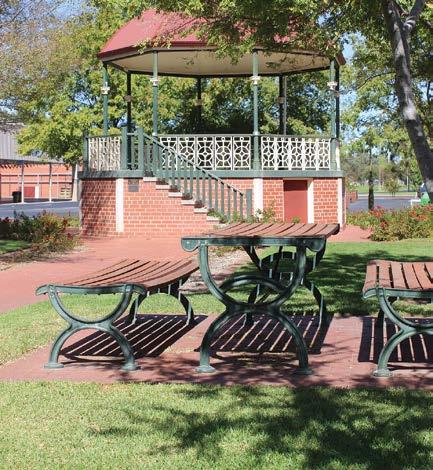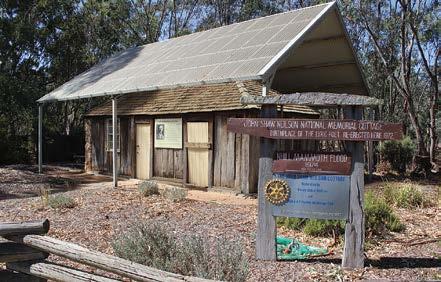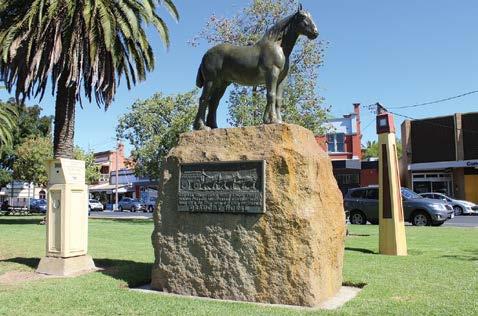
3 minute read
to Explore
Many of the historic buildings along Nelson and Victoria Streets (Western Highway) have plaques recording building dates and past uses. Further information regarding the buildings can be obtained at the Visitor Information Centre or from the Nhill Historical Society. A self-guided tour is available from the Visitor Centre, or download from website: www.hindmarsh.vic.gov.au/Visit-Hindmarsh/ Brochures-and-Maps
Band Rotunda
Advertisement
Funded jointly by Council and the community, the rotunda was erected in 1909. It was extensively refurbished in 2000.
Local Cemeteries
Our local cemeteries contain history from the region and individuals. Anyone interested in contacting the cemetery trusts can call Hindmarsh Shire on 5391 4444 for the local contact. The local cemeteries include Bleak House, Dahwadare, Kiata, Lorquon, Netherby, Nhill, Winiam and Woorak.
Historical Society
The Nhill Historical Society located at 104 -106 MacPherson Street is open 2 – 5pm Tuesday to Thursday and the research officer is available on site from 10am –12pm on Fridays. Contact and requests for information can also be made via email: nhillhistorical@gmail.com
The society is proud of it’s collection of local family history, cemetery records for the Nhill and surrounding district, photographic collection, rate books, and museum displays. Copies of the local newspaper, “The Nhill Free Press – Kaniva Times” from 1882 until the present day are also available.
The museum display includes an extensive collection of John Shaw Neilson memorabilia, crockery, glassware, kitchenware, and household items, wedding dresses dating from 1860 to 1980, embroidery, Lowan Shire honour boards, and photographs.
John Shaw Neilson Cottage
Members of the Nhill & District Historical Society reconstructed the two original rooms of the home in which Nhill’s resident poet John Shaw Neilson was born. The cottage is located on a site adjoining Jaypex Park. Neilson was one of Australia’s great lyric poets. He wrote about his life in and around Nhill.
Malleefowl Memorial


Located at the front of the council offices in Nhill. The Malleefowl is a unique flightless bird, which builds large earth mounds to incubate its eggs.
Nhill Aviation Centre
Famous Aviators who landed at Nhill include Bert Hinkler, Charles Butler, Horrie Miller, Charles KingsfordSmith, Amy Johnson, Jimmy Mollison, and Nancy Bird. Nhill hosted the first East-West Air Race from Sydney to Perth in 1929 as well as the Brisbane – Adelaide Centenary Race in 1936.
Nhill’s aerodrome attained national significance during the Second World War as the site of a Royal Australia Air Force Base. Between 1941 and 1946, approximately 10,000 Air Force personnel trained at Nhill. Aspects of training required a bombing range, which was set up in the Little Desert south of the township. Avro Ansens were the main aircraft used in training, with up to 35 Ansens on the base on any given day.
The centre now displays the three types of training aircraft used at the base: an Avro Ansen, a Wirraway and a Tiger Moth. Plus there is a fantastic display of other memorabilia highlighting the hey-day of the base.
Nhill Railway Station
The section of railway line from Dimboola to Nhill, and then onto the South Australian border was opened on 19 January 1887 at a cost of £514.12. Nhill Railway Station and platform buildings were completed two years later at a cost of £3,783.
Post Office
Nhill Post Office foundation stone was consecrated on 28 October 1887 using corn as plenty, wine as joy, and oil as gladness. The first post office operating in Nhill commenced on 1 September 1861, remaining open until 10 April 1867 when a post office was opened at nearby Lawloit. There were a number of changes to the mail route serving Nhill over the years.
Talking Draught Horse
This monument in Goldsworthy Park is a reminder of the major part the draught horse played in the development of Australia and this region. The memorial, erected in April 1966 was modelled on a Clydesdale and modified to look like the original draught horse. The first two horses arrived in Nhill in 1844. A team of horses hauled Nhill’s first harvest 160km to the nearest rail head at Stawell for delivery to Melbourne.

War Memorials
The World War I memorial was erected in 1920 in memory of the people who lost their lives during this war. This was part of a nationwide project.
All local people who served during World War II are named on an honour board on display in the Nhill Memorial Community Centre.
More recently, in 2011, a Royal Australian Air Force memorial was erected to honour those who served.









